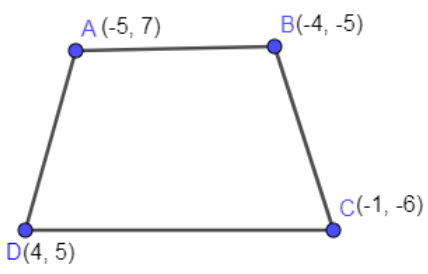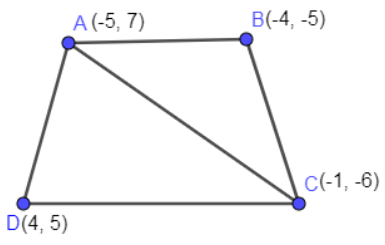
Answer
430.2k+ views
Hint: First of all, draw a quadrilateral ABCD. Then we will draw a diagonal in the quadrilateral. After drawing the diagonal, the quadrilateral is divided into two triangles. Then we will find the area of each of the triangles by using the formula of the area of triangle having three points i.e. $\dfrac{1}{2}\left| \begin{matrix}
{{x}_{1}} & {{y}_{1}} & 1 \\
{{x}_{2}} & {{y}_{2}} & 1 \\
{{x}_{3}} & {{y}_{3}} & 1 \\
\end{matrix} \right|$ and then we will add the area of two triangles to get the area of the quadrilateral ABCD.
Complete step-by-step solution:
Let us draw a quadrilateral ABCD with coordinates of A, B, C and D as follows:

Now, joining A and C to get the diagonal AC and joining B and D to get the diagonal BD in the above diagram we get,

Now, we are going to find the area of the triangles ACD and ABC.
We know that formula for area of triangle having three points $\left( {{x}_{1}},{{y}_{1}} \right),\left( {{x}_{2}},{{y}_{2}} \right),\left( {{x}_{3}},{{y}_{3}} \right)$ is as follows:
$\dfrac{1}{2}\left| \begin{matrix}
{{x}_{1}} & {{y}_{1}} & 1 \\
{{x}_{2}} & {{y}_{2}} & 1 \\
{{x}_{3}} & {{y}_{3}} & 1 \\
\end{matrix} \right|$
Now, we are going to find the area of triangle ACD by taking A (-5, 7), C (-1, -6), D (4, 5) as $\left( {{x}_{1}},{{y}_{1}} \right),\left( {{x}_{2}},{{y}_{2}} \right),\left( {{x}_{3}},{{y}_{3}} \right)$ in the above formula and we get,
$\Rightarrow \dfrac{1}{2}\left| \begin{matrix}
-5 & 7 & 1 \\
-1 & -6 & 1 \\
4 & 5 & 1 \\
\end{matrix} \right|$
Applying the following operations in the above determinant we get,
$\begin{align}
& {{R}_{2}}\to {{R}_{2}}-{{R}_{1}} \\
& {{R}_{3}}\to {{R}_{3}}-{{R}_{1}} \\
\end{align}$
$\begin{align}
& \Rightarrow \dfrac{1}{2}\left| \begin{matrix}
-5 & 7 & 1 \\
-1-\left( -5 \right) & -6-7 & 1-1 \\
4-\left( -5 \right) & 5-7 & 1-1 \\
\end{matrix} \right| \\
& =\dfrac{1}{2}\left| \begin{matrix}
-5 & 7 & 1 \\
-1+5 & -13 & 0 \\
4+5 & -2 & 0 \\
\end{matrix} \right| \\
& =\dfrac{1}{2}\left| \begin{matrix}
-5 & 7 & 1 \\
4 & -13 & 0 \\
9 & -2 & 0 \\
\end{matrix} \right| \\
\end{align}$
Expanding the above determinant along third column we get,
$\begin{align}
& =\dfrac{1}{2}\left[ 4\left( -2 \right)-9\left( -13 \right) \right] \\
& =\dfrac{1}{2}\left[ -8+117 \right] \\
& =\dfrac{1}{2}\left[ 109 \right] \\
\end{align}$
From the above, we have calculated the area of triangle ACD as $\dfrac{109}{2}$sq. units.
Now, we are going to find the area of triangle ABC by taking A (-5, 7), B (-4, -5), C (-1, -6), as $\left( {{x}_{1}},{{y}_{1}} \right),\left( {{x}_{2}},{{y}_{2}} \right),\left( {{x}_{3}},{{y}_{3}} \right)$ in the above formula and we get,
$\Rightarrow \dfrac{1}{2}\left| \begin{matrix}
-5 & 7 & 1 \\
-4 & -5 & 1 \\
-1 & -6 & 1 \\
\end{matrix} \right|$
Applying the following operations in the above determinant we get,
$\begin{align}
& {{R}_{2}}\to {{R}_{2}}-{{R}_{1}} \\
& {{R}_{3}}\to {{R}_{3}}-{{R}_{1}} \\
\end{align}$
$\begin{align}
& \Rightarrow \dfrac{1}{2}\left| \begin{matrix}
-5 & 7 & 1 \\
-4-\left( -5 \right) & -5-7 & 1-1 \\
-1-\left( -5 \right) & -6-7 & 1-1 \\
\end{matrix} \right| \\
& =\dfrac{1}{2}\left| \begin{matrix}
-5 & 7 & 1 \\
-4+5 & -12 & 0 \\
-1+5 & -13 & 0 \\
\end{matrix} \right| \\
& =\dfrac{1}{2}\left| \begin{matrix}
-5 & 7 & 1 \\
1 & -12 & 0 \\
4 & -13 & 0 \\
\end{matrix} \right| \\
\end{align}$
Expanding the above determinant along third column we get,
$\begin{align}
& =\dfrac{1}{2}\left[ 1\left( -13 \right)-4\left( -12 \right) \right] \\
& =\dfrac{1}{2}\left[ -13+48 \right] \\
& =\dfrac{1}{2}\left[ 35 \right] \\
\end{align}$
From the above, we have calculated the area of triangle ABC as $\dfrac{35}{2}$sq. units.
Now, adding the areas of triangles ABC and ACD we get,
$\begin{align}
& \Rightarrow \Delta ABC+\Delta ACD \\
& =\dfrac{35}{2}+\dfrac{109}{2} \\
& =\dfrac{144}{2} \\
& =72 \\
\end{align}$
Hence, we have calculated the area of quadrilateral ABCD is 72 sq. units.
Note: The possible mistake that could be possible in the above problem is the calculation mistake as you can see that rigorous calculation is involved in finding the area of the two triangles which is made by drawing the diagonals. Also, in evaluating the determinant in the above problem we have used the row operations to minimize the calculations.
$\Rightarrow \dfrac{1}{2}\left| \begin{matrix}
-5 & 7 & 1 \\
-4 & -5 & 1 \\
-1 & -6 & 1 \\
\end{matrix} \right|$
Applying the following operations in the above determinant we get,
$\begin{align}
& {{R}_{2}}\to {{R}_{2}}-{{R}_{1}} \\
& {{R}_{3}}\to {{R}_{3}}-{{R}_{1}} \\
\end{align}$
The other way to evaluate the above determinant is not to apply the row operations and do the expansion of the determinant along the first row but then chances of making calculations will be higher than in the ones which we have done above.
{{x}_{1}} & {{y}_{1}} & 1 \\
{{x}_{2}} & {{y}_{2}} & 1 \\
{{x}_{3}} & {{y}_{3}} & 1 \\
\end{matrix} \right|$ and then we will add the area of two triangles to get the area of the quadrilateral ABCD.
Complete step-by-step solution:
Let us draw a quadrilateral ABCD with coordinates of A, B, C and D as follows:

Now, joining A and C to get the diagonal AC and joining B and D to get the diagonal BD in the above diagram we get,

Now, we are going to find the area of the triangles ACD and ABC.
We know that formula for area of triangle having three points $\left( {{x}_{1}},{{y}_{1}} \right),\left( {{x}_{2}},{{y}_{2}} \right),\left( {{x}_{3}},{{y}_{3}} \right)$ is as follows:
$\dfrac{1}{2}\left| \begin{matrix}
{{x}_{1}} & {{y}_{1}} & 1 \\
{{x}_{2}} & {{y}_{2}} & 1 \\
{{x}_{3}} & {{y}_{3}} & 1 \\
\end{matrix} \right|$
Now, we are going to find the area of triangle ACD by taking A (-5, 7), C (-1, -6), D (4, 5) as $\left( {{x}_{1}},{{y}_{1}} \right),\left( {{x}_{2}},{{y}_{2}} \right),\left( {{x}_{3}},{{y}_{3}} \right)$ in the above formula and we get,
$\Rightarrow \dfrac{1}{2}\left| \begin{matrix}
-5 & 7 & 1 \\
-1 & -6 & 1 \\
4 & 5 & 1 \\
\end{matrix} \right|$
Applying the following operations in the above determinant we get,
$\begin{align}
& {{R}_{2}}\to {{R}_{2}}-{{R}_{1}} \\
& {{R}_{3}}\to {{R}_{3}}-{{R}_{1}} \\
\end{align}$
$\begin{align}
& \Rightarrow \dfrac{1}{2}\left| \begin{matrix}
-5 & 7 & 1 \\
-1-\left( -5 \right) & -6-7 & 1-1 \\
4-\left( -5 \right) & 5-7 & 1-1 \\
\end{matrix} \right| \\
& =\dfrac{1}{2}\left| \begin{matrix}
-5 & 7 & 1 \\
-1+5 & -13 & 0 \\
4+5 & -2 & 0 \\
\end{matrix} \right| \\
& =\dfrac{1}{2}\left| \begin{matrix}
-5 & 7 & 1 \\
4 & -13 & 0 \\
9 & -2 & 0 \\
\end{matrix} \right| \\
\end{align}$
Expanding the above determinant along third column we get,
$\begin{align}
& =\dfrac{1}{2}\left[ 4\left( -2 \right)-9\left( -13 \right) \right] \\
& =\dfrac{1}{2}\left[ -8+117 \right] \\
& =\dfrac{1}{2}\left[ 109 \right] \\
\end{align}$
From the above, we have calculated the area of triangle ACD as $\dfrac{109}{2}$sq. units.
Now, we are going to find the area of triangle ABC by taking A (-5, 7), B (-4, -5), C (-1, -6), as $\left( {{x}_{1}},{{y}_{1}} \right),\left( {{x}_{2}},{{y}_{2}} \right),\left( {{x}_{3}},{{y}_{3}} \right)$ in the above formula and we get,
$\Rightarrow \dfrac{1}{2}\left| \begin{matrix}
-5 & 7 & 1 \\
-4 & -5 & 1 \\
-1 & -6 & 1 \\
\end{matrix} \right|$
Applying the following operations in the above determinant we get,
$\begin{align}
& {{R}_{2}}\to {{R}_{2}}-{{R}_{1}} \\
& {{R}_{3}}\to {{R}_{3}}-{{R}_{1}} \\
\end{align}$
$\begin{align}
& \Rightarrow \dfrac{1}{2}\left| \begin{matrix}
-5 & 7 & 1 \\
-4-\left( -5 \right) & -5-7 & 1-1 \\
-1-\left( -5 \right) & -6-7 & 1-1 \\
\end{matrix} \right| \\
& =\dfrac{1}{2}\left| \begin{matrix}
-5 & 7 & 1 \\
-4+5 & -12 & 0 \\
-1+5 & -13 & 0 \\
\end{matrix} \right| \\
& =\dfrac{1}{2}\left| \begin{matrix}
-5 & 7 & 1 \\
1 & -12 & 0 \\
4 & -13 & 0 \\
\end{matrix} \right| \\
\end{align}$
Expanding the above determinant along third column we get,
$\begin{align}
& =\dfrac{1}{2}\left[ 1\left( -13 \right)-4\left( -12 \right) \right] \\
& =\dfrac{1}{2}\left[ -13+48 \right] \\
& =\dfrac{1}{2}\left[ 35 \right] \\
\end{align}$
From the above, we have calculated the area of triangle ABC as $\dfrac{35}{2}$sq. units.
Now, adding the areas of triangles ABC and ACD we get,
$\begin{align}
& \Rightarrow \Delta ABC+\Delta ACD \\
& =\dfrac{35}{2}+\dfrac{109}{2} \\
& =\dfrac{144}{2} \\
& =72 \\
\end{align}$
Hence, we have calculated the area of quadrilateral ABCD is 72 sq. units.
Note: The possible mistake that could be possible in the above problem is the calculation mistake as you can see that rigorous calculation is involved in finding the area of the two triangles which is made by drawing the diagonals. Also, in evaluating the determinant in the above problem we have used the row operations to minimize the calculations.
$\Rightarrow \dfrac{1}{2}\left| \begin{matrix}
-5 & 7 & 1 \\
-4 & -5 & 1 \\
-1 & -6 & 1 \\
\end{matrix} \right|$
Applying the following operations in the above determinant we get,
$\begin{align}
& {{R}_{2}}\to {{R}_{2}}-{{R}_{1}} \\
& {{R}_{3}}\to {{R}_{3}}-{{R}_{1}} \\
\end{align}$
The other way to evaluate the above determinant is not to apply the row operations and do the expansion of the determinant along the first row but then chances of making calculations will be higher than in the ones which we have done above.
Recently Updated Pages
Fill in the blanks with suitable prepositions Break class 10 english CBSE

Fill in the blanks with suitable articles Tribune is class 10 english CBSE

Rearrange the following words and phrases to form a class 10 english CBSE

Select the opposite of the given word Permit aGive class 10 english CBSE

Fill in the blank with the most appropriate option class 10 english CBSE

Some places have oneline notices Which option is a class 10 english CBSE

Trending doubts
Fill the blanks with the suitable prepositions 1 The class 9 english CBSE

How do you graph the function fx 4x class 9 maths CBSE

Which are the Top 10 Largest Countries of the World?

What is the definite integral of zero a constant b class 12 maths CBSE

The Equation xxx + 2 is Satisfied when x is Equal to Class 10 Maths

Differentiate between homogeneous and heterogeneous class 12 chemistry CBSE

Define the term system surroundings open system closed class 11 chemistry CBSE

Full Form of IASDMIPSIFSIRSPOLICE class 7 social science CBSE

Change the following sentences into negative and interrogative class 10 english CBSE




